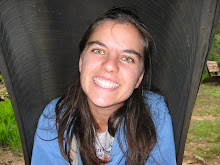I'm getting my cheesemaking chops back in action! My neighbor gets a regular supply of fresh raw goat milk from a local farm, so we teamed up to make chevre. I had the starter culture and the instructions, thanks to the New England Cheesemaking Supply (they're the folks Barbara Kingsolver wrote about in Animal, Vegetable, Miracle). We weren't sure about using the unpasteurized milk - we figured it's probably fine since they drink it all the time - so we decided to experiment with two batches, the raw stuff and some storebought milk. Unfortunately, the only goat milk still on the shelves at the store was ultrapasteurized and low fat. Not ideal, but hey, we're flexible.
I almost hate to reveal how simple it is to make this kind of cheese, for fear of losing some of the sparkle, but it really is simple: heat the milk to 86 degrees, turn off heat, stir in culture, cover and ignore for about 12 hours or until it sets to a yogurt-like consistency. Ideally the room should be about 72 degrees. Then line a colander with butter muslin and gently transfer your cheese, hanging to drain for another 12 hours or until it's as thick as you want it. Eat, delighting in your creation!
The tricky thing for me about cheese, even one as simple as this, is that I am not good with scientific precision. When I cook, I often ignore measurements, or approximate them. This is more or less a cup, right? And I'm not really sure how much it matters - all the experts make a big deal of exact temperatures and times and equipment, but I usually end up messing it up somehow - and then it turns out delicious anyway, but it's hard to know what effect my haphazard ways have on the final product.
In this case each pot of milk got warmer than they should have, up to 90 or 95 even (milk gets to 86 fast!). The division of the starter culture - an envelope with about 3/4 teaspoon of powder in it - may not have been exact, so one may have had a bit more than the other. I'm not sure what the room temperature was - probably around 70, and fluctuating through the day. It set for about 10 or 11 hours, not 12. We didn't have two pieces of butter muslin so we folded over layers of a wide-mesh cheesecloth for the store milk. Um...that may have been it, for variables. Not such a good experiment, then, since we aren't sure why they came out differently. Oh, and most importantly, we forgot to taste the two milks first to compare them in that form!
But: delicious results. Totally different, both yummy. And so beautiful and pure and white. The whole raw milk came out more or less as I expected, recognizably chevre. The flavor seems a bit more sour than I associate with it, but only a bit. (and maybe that's because I don't usually eat it for breakfast) The storebought ultrapasteurized low fat milk came out very wet and creamy, sort of like a mix of yogurt and sour cream. But I happily savored spoonfuls of it early in the morning, and had to put it away before I ate it all.
As I said, no idea which variables caused the difference. Only one way to find out: try again! Soft cheese are great for their relatively instant gratification. One of these days I'll build a cheese press and make some hard cheeses, but it's that much harder to repeat experiments when you have to wait 6 months to taste. Now I just need to find someone local with sheep, or water buffalo...mmm....
Subscribe to:
Post Comments (Atom)

No comments:
Post a Comment